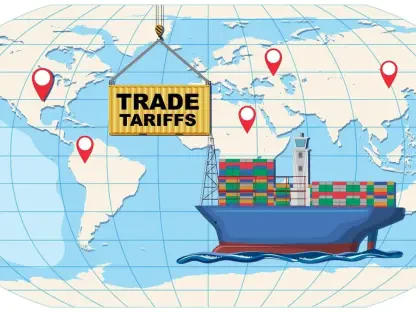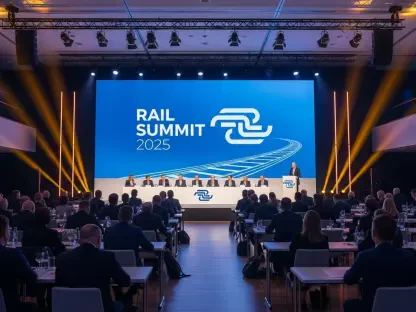In the ever-shifting landscape of logistics and transportation, companies like ArcBest (NASDAARCB) face a constant barrage of economic and operational challenges that can swiftly alter financial projections, leading to significant adjustments. Recently, this prominent player in the industry announced a downward revision of its third-quarter (Q3) margin outlook for its asset-based segment, which includes the less-than-truckload (LTL) subsidiary ABF Freight. This unexpected adjustment has sparked curiosity and concern among investors and industry watchers alike. What factors led to this recalibration of expectations? From macroeconomic headwinds to internal cost pressures, the reasons behind this revision paint a complex picture of an industry grappling with soft demand and rising expenses. Delving into the specifics of ArcBest’s performance and strategic responses offers valuable insight into the broader challenges facing the LTL sector today, highlighting the delicate balance between growth and profitability in a tough economic climate.
Economic Headwinds Impacting Performance
The broader economic environment has played a significant role in shaping ArcBest’s revised Q3 margin outlook. Persistent weakness in key sectors such as manufacturing and housing has directly affected freight volumes, with lighter shipment weights dragging down revenue efficiency. This trend aligns with economic indicators like the Purchasing Managers’ Index (PMI), which recorded a reading of 48.7 in August, signaling ongoing contraction in manufacturing activity for a prolonged period. While the PMI new orders subindex showed a marginal uptick to 51.4, it remains below the critical 52.1 threshold needed for sustained growth in manufacturing orders. This sluggish environment suggests that a near-term recovery in LTL volumes is unlikely, placing continuous pressure on companies like ArcBest to adapt to reduced demand. The ripple effects of these conditions are evident in the company’s inability to achieve previously anticipated margin improvements, as external factors beyond its control weigh heavily on financial outcomes.
Furthermore, ArcBest’s experience mirrors a broader industry struggle, with other major LTL carriers also reporting muted growth or tonnage declines in recent months. The freight cycle, which many had hoped would turn by now, remains stubbornly stagnant, tied to the slow recovery of core economic drivers. For ArcBest, the impact is clear in the asset-based segment’s modest 2% year-over-year revenue increase for August, driven by a 5% rise in daily shipments but offset by a 3% drop in weight per shipment. This imbalance underscores how macroeconomic challenges translate into tangible operational hurdles. The revised operating ratio (OR) guidance for Q3, now projected at approximately 93.1% at the midpoint, represents a significant downgrade from earlier expectations of a 70 basis point improvement. This adjustment highlights the pervasive influence of a subdued economy on ArcBest’s ability to maintain profitability amidst declining shipment efficiency and persistent demand softness.
Operational Challenges and Cost Pressures
On the operational front, ArcBest has encountered substantial hurdles that have contributed to the downward revision of its Q3 margin outlook. One of the most pressing issues is the spike in cartage expenses, driven by the need to rely on external capacity to manage recent business wins in specific markets. While the company anticipates a reduction in these costs as staffing levels are adjusted, the immediate financial burden has been significant. This reliance on outside resources reflects temporary inefficiencies that have eroded margins in the short term. Additionally, the asset-based segment’s performance, while showing a 2% tonnage increase in August, is tempered by ongoing yield pressures, with year-over-year declines evident in prior months. These operational challenges paint a picture of a company striving to balance growth opportunities with the rising costs of maintaining service levels in a competitive landscape.
Beyond cartage costs, ArcBest faces internal pressures from pricing dynamics that have yet to fully stabilize. Despite implementing a 5.9% general rate increase in early August and a similar hike in September, yields remain under strain, with flat performance in August following declines of 3.1% in Q2 and 1.2% in July. A pricing review has identified opportunities for targeted adjustments on specific accounts and lanes, aiming to bolster LTL profitability. However, the impact of these initiatives will likely unfold gradually, offering little immediate relief to the current margin squeeze. The asset-light segment, encompassing truck brokerage operations, adds another layer of complexity, with an expected breakeven to $1 million in adjusted operating income for Q3 despite an 8% year-over-year revenue decline. This drop, attributed to a 10% decrease in revenue per shipment, underscores the multifaceted cost challenges ArcBest must navigate while striving to maintain operational stability across diverse business units.
Strategic Responses and Market Reactions
In response to these mounting challenges, ArcBest has taken proactive steps to safeguard margins and position itself for future stability. The aforementioned general rate increases are a cornerstone of this strategy, designed to counteract yield declines and improve revenue per shipment over time. Additionally, the company is focusing on optimizing its operational footprint by addressing staffing imbalances and reducing reliance on costly external capacity. These efforts, while promising, require time to yield measurable results, leaving ArcBest vulnerable to near-term margin compression as reflected in the revised Q3 operating ratio guidance. The asset-based segment’s gradual stabilization in tonnage trends, with a 7.9% decline in August on a two-year stacked basis compared to steeper drops earlier, offers a glimmer of hope, but it is not enough to offset the broader profitability concerns dominating the current quarter.
Market sentiment has also reflected the gravity of ArcBest’s revised outlook, with shares dropping 3.2% in early trading on the day of the announcement, in stark contrast to a modest 0.1% uptick in the S&P 500. This negative reaction underscores investor unease about the company’s ability to navigate persistent economic and operational headwinds. While ArcBest’s strategic adjustments align with industry-wide efforts to protect profitability, the immediate financial impact of higher costs and soft demand remains a sticking point. The broader narrative within the LTL sector suggests that recovery hinges on sustained improvements in manufacturing and housing demand, factors largely outside the company’s direct control. As ArcBest continues to refine its pricing and operational strategies, the market watches closely, weighing the potential for long-term gains against the undeniable short-term pressures that have reshaped its Q3 expectations.
Path Forward Amid Uncertainty
Reflecting on the events surrounding ArcBest’s Q3 margin revision, it becomes evident that a confluence of external and internal factors has driven the company to reassess its financial trajectory. The persistent economic softness, marked by contracting manufacturing activity, has stifled demand and shipment weights, while rising cartage expenses and yield pressures have compounded operational difficulties. Strategic moves like rate hikes and pricing reviews have been initiated to counter these challenges, yet their effects are not immediate enough to prevent a downward adjustment in the operating ratio guidance.
Looking ahead, the focus for ArcBest and its stakeholders shifts to actionable steps that can mitigate ongoing uncertainties. Prioritizing operational efficiency through reduced external capacity costs and fine-tuned staffing levels will be critical. Simultaneously, sustained efforts to enhance pricing structures could gradually restore yield stability. Industry observers anticipate that broader economic recovery will play a pivotal role, and monitoring indicators like the PMI for signs of sustained growth becomes essential. As ArcBest navigates these turbulent waters, the emphasis on adaptability and strategic foresight emerges as key to weathering the storm and positioning for future success in a challenging freight landscape.









